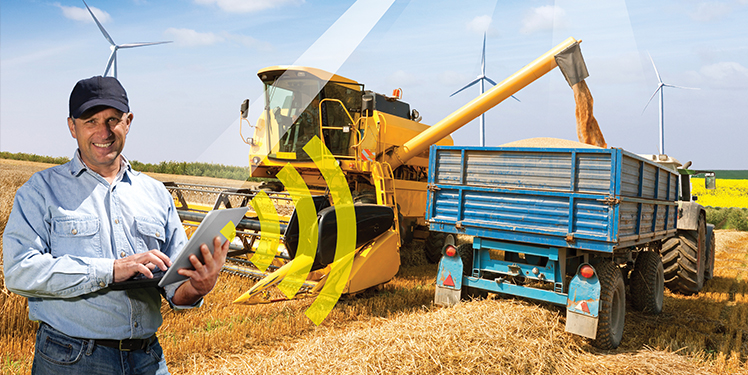The clock is ticking. With every passing second, the world population is growing, while the areas for agricultural use are decreasing. This means that we must be able to feed more and more people, but resources such as water and food are becoming increasingly scarce. These problems will be exacerbated even more in the future, as emphasized by the business association CEMA: “We will need to produce more food in the next 50 years than we did in the past 10.000 years.” The solution to this challenge could be Agriculture 4.0. What exactly this means was explained by Dr. Pablo Oliveira Antonino during his presentation in São Paulo, Brazil, in the context of the event “Agro 4.0 – Digitization in the Field”, which was held by the German-Brazilian Chamber of Commerce and Industry on 13 August 2018. Interview with Dr. Pablo Oliveira Antonino:
What exactly does Agriculture 4.0 mean?
To understand this, we must first take a look at the development of agriculture, which can be divided into four phases: The first phase, that is, Agriculture 1.0, started in the 19th century. At that time, machinery was still operated manually and farm implements were drawn by horses, for example. Agriculture 2.0 started at the end of the 1950s/beginning of the1960s and aimed at improved performance of the field. One of the main characteristics of Agriculture 2.0 was the first use of pesticides. From this time on, agriculture has been developing towards agrobusiness. The use of GPS and navigation systems in the 1990s was the start of Agriculture 3.0. Officially, we are still at the end of this period, although the planning phase of Agriculture 4.0 has already started. Here, software and electronics are to be combined in order to simplify agricultural tasks. Under the motto “Precision Farming”, the idea is to use fewer resources to produce more. In this context, topics such as Big Data, Autonomous Driving, and AI Systems are of particular importance, as they present completely new opportunities for agriculture.
How can we envision this future in practice?
One of the great advantages of Agriculture 4.0 is the use of software systems. These systems make it possible to identify weak points in an agriculturally cultivated field. This is particularly important for countries such as Brazil, where farms often extend over many square kilometers, as the use of cameras, drones, and AI systems enables specific diagnosis of areas of the field where cultivation is not optimal. Once this data has been transmitted to the system, agricultural machinery can now be deployed in a focused manner to specific areas. This means that no resources are wasted, as they can be precisely adapted to the requirements of the field. Agriculture 4.0 therefore not only means an improvement of the agricultural performance of the field, but also enables enormous savings in terms of material and cost.
To which extent does IESE play an important role in this?
Fraunhofer IESE operates at the interface between electronics and software. Our aim is to understand the status quo of the architecture of a machine in order to derive requirements for autonomous systems from it and to provide support for the development of such systems. In doing so, we rely on both our internal research and our many years of collaboration with our partner John Deere. In the context of various projects we are working on enabling Precision Agriculture. Software and its integration into electronics is an important part of this to identify the requirements of a field.
What was your contribution to the event?
I wanted to illustrate the topic of Agriculture 4.0 from different angles. This is why I structured my presentation into two parts: In the first part, I talked about the trends and technologies in Agriculture 4.0. One highlight was a closer examination of the collaboration between Fraunhofer IESE and John Deere. One of the central questions was: How can we combine our lessons learned from the automotive sector with future requirements on agriculture? In addition to these technical challenges, I also presented concrete practical cases and experiences with our collaboration partner John Deere. In the second part of my presentation, I talked about the requirements for tasks in the field and for monitoring.
What were your expectations regarding the event?
I mainly hoped to be able to expand my knowledge about this domain. What exactly is the significance of the Brazilian market for Autonomous Systems? In addition, my aim was, of course, also to acquire potential customers. At the same time, Agriculture 4.0 is a topic that affects many other areas. My participation in this event was therefore not only beneficial for the further development of Agriculture 4.0, but also for related research areas such as Industrie 4.0, Big Data, or AI.
A final word?
Agriculture 4.0 and Smart Farming are very large trends with challenges that we will not be able to master within the next ten years… but we must not stop working on finding solutions!

